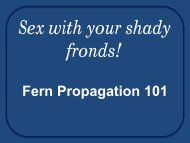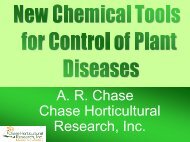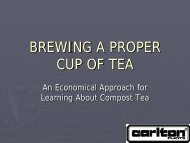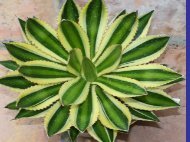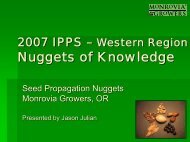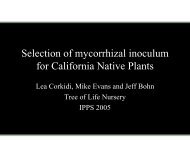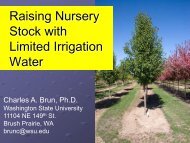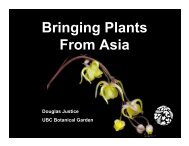Managing Production Risks in the Nursery
Managing Production Risks in the Nursery
Managing Production Risks in the Nursery
- No tags were found...
You also want an ePaper? Increase the reach of your titles
YUMPU automatically turns print PDFs into web optimized ePapers that Google loves.
<strong>Manag<strong>in</strong>g</strong> <strong>Production</strong> <strong>Risks</strong><strong>in</strong> <strong>the</strong> <strong>Nursery</strong>Ursula SchuchTrent TeegerstromSchool of Plant Sciences Ag Economics DepartmentUniversity of ArizonaTucson, AZ 85721USDA Outreach Program
Risk Management• F<strong>in</strong>ance• Market<strong>in</strong>g• Human resources• Legal• <strong>Production</strong>Which risks are most relevant <strong>in</strong> your nursery?
Labor accounts for 30-60% of production costs <strong>in</strong> agriculture.Estimated cost to replace an hourlyworker is $1,000 – 3,000.Human Resources
Costs for replac<strong>in</strong>g a worker• Lost productivity until replacement is found• Co-workers tak<strong>in</strong>g on extra work• Advertis<strong>in</strong>g and recruitment• Tra<strong>in</strong><strong>in</strong>g new employee• 2 months on average for full productivity• Ex.: $2,288 turnover for a worker @ $9.50/hhttp://www.uwex.edu/ces/cced/economies/turn.cfm#calcHow much does you employee turnover cost?Univ. of WI, Center for Community and Economic Development
<strong>Nursery</strong> workforce is diverse• 70% Hispanic• < 25% understand English• 66% not tra<strong>in</strong>ed, have <strong>in</strong>terest <strong>in</strong> tra<strong>in</strong><strong>in</strong>g• Half of laborers leave a nursery after 5 years• 5% stay with same nursery after 10 years• Tra<strong>in</strong><strong>in</strong>g can improve retention of workers• English fluency, benefits, salary, accidents aregreatest concerns of workers(Ma<strong>the</strong>rs 2003; Ma<strong>the</strong>rs et al., 2010)
Ag Help Wanted – Guidel<strong>in</strong>es for<strong>Manag<strong>in</strong>g</strong> Agricultural Labor• Tools and tips for deal<strong>in</strong>g with staff<strong>in</strong>g,supervis<strong>in</strong>g, manag<strong>in</strong>g employeeperformance, improv<strong>in</strong>g communication,problem solv<strong>in</strong>g($25 paper, web free)• Rosenberg et al., 2002• www.AgHelpWanted.org
Mechanization or automation is more prevalent• <strong>in</strong> greenhouse only operations compared tonurseries• <strong>in</strong> nurseries on larger acreage• <strong>in</strong> operations with gross sales > $250,000• <strong>in</strong> nurseries that used computers to scheduleproductionResults from a survey of operations of <strong>the</strong> Nor<strong>the</strong>rn Gulf of Mexico states (2004-05)Project: Enhanc<strong>in</strong>g labor performance of <strong>the</strong> green <strong>in</strong>dustry(http://coastal.msstate.edu/nurseryautomation.html)
Survey results from seven Sou<strong>the</strong>rn states from nursery andnursery/greenhouse operations (2003-2008, n=137)Task Performed manually <strong>in</strong> %of operations surveyedConta<strong>in</strong>er fill<strong>in</strong>g 47Plant placed <strong>in</strong> conta<strong>in</strong>ers 69Mov<strong>in</strong>g conta<strong>in</strong>ers from pott<strong>in</strong>garea to transport vehiclesTransport conta<strong>in</strong>ers to field 36Placed conta<strong>in</strong>ers <strong>in</strong> field 75Spaced conta<strong>in</strong>ers 80Plant prun<strong>in</strong>g, pesticideapplicationFertilizer application 69Irrigation 226140
Mechanization• Mechanization = replacement of human tasks withmach<strong>in</strong>es• Automation = Use of several mechanized systems <strong>in</strong>a facilityMechanization resulted <strong>in</strong>:• Increased efficiency• Improved workers earn<strong>in</strong>gs• Did not result <strong>in</strong> worker displacement• Resulted <strong>in</strong> higher sales
Conveyer belts for mov<strong>in</strong>g potted plants
Green Elf ® battery powered dispenser301 Series f<strong>in</strong>e gra<strong>in</strong> materials (herbicides, 0.1 – 5.5 g)501 Series controlled release or slow release fertilizer (2.5 - 78 g)Automated use for mount<strong>in</strong>g on pott<strong>in</strong>g mach<strong>in</strong>es50% or more reduction <strong>in</strong> labor time22,000 – 30,000 pots a dayCost ~ $1,900
• Robots to space potsMechanization– Work <strong>in</strong> greenhouse, hoop house, nursery– Space, collect, re-space, consolidate pots– works <strong>in</strong> teams with human workers– Moves 200-300 conta<strong>in</strong>ers per hour– Cost $25,000, estimated payback time with<strong>in</strong> 12-24 months
Systems improvements• Inventory management for productionplann<strong>in</strong>g and forecast<strong>in</strong>g• ERP Software for <strong>in</strong>stant access by manyemployees– Enterprise resource plann<strong>in</strong>g (ERP) <strong>in</strong>tegratesf<strong>in</strong>ancial, manufactur<strong>in</strong>g, sales, HR,
Ag. & Resource Economics Dept.and School of Plant SciencesCollege of Tropical Agricultureand Human ResourcesUniversity of Hawaii at Manoa<strong>Nursery</strong> Cost/Profit EstimatorHow much does it cost to produce l<strong>in</strong>ers?Is a plant more profitable to sell as #2 or #5?How long should I keep plants that don’t sell?What is my overhead cost $/squ. ft/week?- for outdoor, greenhouse, shade house
This sheet summarizes all <strong>the</strong> results of <strong>the</strong> template.The first part lists (1) each product, (2) <strong>the</strong> expected sales price (enter price onthis page), (3) cost estimated by <strong>the</strong> spreadsheet, and (4) <strong>the</strong> expected profit.
Many nurseries purchaseproducts from o<strong>the</strong>rgrowers. The second partallows you to comparebuy<strong>in</strong>g a product aga<strong>in</strong>stgrow<strong>in</strong>g it.Black = growRed = buy
Green = dataThe first part asks for <strong>in</strong>formation from your map.“% open” = <strong>the</strong> amount of space that is typically empty at any given time.Our aim = f<strong>in</strong>d <strong>the</strong> “work<strong>in</strong>g” space or square footage that actually earnsrevenue.
• names of <strong>the</strong> stock plants• area usedStock Plants sheet• total unused space <strong>in</strong> <strong>the</strong> stock plant area• number of units produced annually. units - appropriate for thatplant
Analysis and Comp(arison) sheetCollects <strong>in</strong>formation from o<strong>the</strong>r worksheets and summarizes to get <strong>the</strong> totalcost per unit for each plant.Calculates <strong>the</strong> expected profit for <strong>the</strong> sales price we enter.
• Risk Management website Univ. of Arizonahttp://ag.arizona.edu/extension/riskmanagement/manag<strong>in</strong>g_f<strong>in</strong>ance_risk/<strong>in</strong>dex.htmlOrder form for spreadsheet: ($50)http://ag.arizona.edu/extension/riskmanagement/manag<strong>in</strong>g_f<strong>in</strong>ance_risk/nurserysoftwarepurchaseform.pdf
Risk Management Agency:<strong>Nursery</strong> Insurance ProductsUSDA Outreach Program
Why buy <strong>in</strong>surance for nursery crops?• Manage risk of nursery crops– Perishable– Wea<strong>the</strong>r– Market<strong>in</strong>g risk– <strong>Production</strong> risks
Products for Nurseries• <strong>Nursery</strong> Insurance• Adjusted Gross Revenue (AGR)• AGR-Lite• <strong>Nursery</strong> <strong>in</strong>surance available nationwide• AGR and AGR Lite differs by state and county
<strong>Nursery</strong> Crop Insurance• Complex crop <strong>in</strong>surance program• Asset based - doesn’t guarantee yield or m<strong>in</strong>imumamount of revenue• For wholesale nurseries (wholesale revenues >retail revenues)• Amount of <strong>in</strong>surance provided is based on reportedPlant Inventory Value (PIVR)• > 20,500 plants on <strong>the</strong> RMA Eligible Plant List andRMA Plant Price Schedule with > 500,000 plantprices
Determ<strong>in</strong>e PlantInventory ValueComputepaymentDecide on coverage levelHow<strong>Nursery</strong>InsuranceWorksDeterm<strong>in</strong>edeductibleDeterm<strong>in</strong>e amount of loss
Adjusted Gross Revenue (AGR)and AGR-Lite for Nurseries+ Whole-farm revenue <strong>in</strong>surance product+ Insurable Causes of Loss:* Revenue loss from natural causes (yield loss)* Revenue loss from market fluctuation (price drop)+ Stand alone or <strong>in</strong> addition to o<strong>the</strong>r coverage+ Average annual adjusted gross revenue less than$2,051,282 (AGR-Lite)+ Non-traditional coverage -- tax year
Premium or <strong>in</strong>surance cost to producer ishighly subsidized by governmentCoverageLevel*65%75%80%GovernmentSubsidy%59%55%48%You pay%41%45%52%* Coverage level = % of eligible revenue that can be<strong>in</strong>sured
Determ<strong>in</strong>e 5 - yearaverage farm revenueAGR revenueguarantee m<strong>in</strong>usactual crop revenue Xpayment rate = losspaidProject 2013 expectedcrop revenueHow AGR &AGR-Lite WorkTaxes filed & possibleclaim calculatedDeterm<strong>in</strong>e “adjusted grossrevenue” (AGR)Decide whatpercentage of AGR toguaranteeHarvest: Actualcrop revenuedeterm<strong>in</strong>ed
Access<strong>in</strong>g or Gett<strong>in</strong>g a Quotewww.rma.usda.gov



